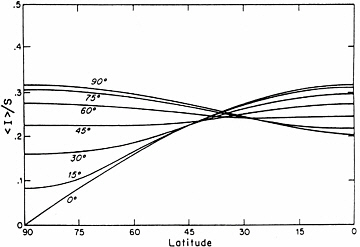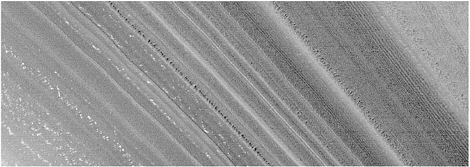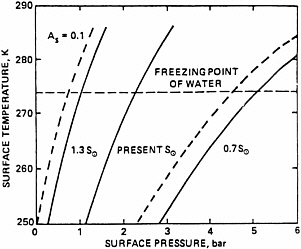9
Climate Change
PRESENT STATE OF KNOWLEDGE
Climate encompasses a broad range of complex, interacting systems with a wide range of time scales. The Mars climate system, which includes the surface, atmosphere, polar caps, and accessible regions of the subsurface, has undergone significant change during the planet’s history. Our knowledge of the martian climate can be organized according to the three time scales over which the climate is expected to vary: (1) interannual climatic variability, (2) quasi-periodic climate variations, and (3) long-term climate change.
Interannual Climatic Variability
Martian climate variability on interannual time scales is an interesting topic from many points of view. Because of the short radiative time constant of the martian atmosphere and its lack of ocean heat storage, one would not expect the martian climate to undergo significant variations on interannual time scales. Yet, with detailed examination of the multidecade telescopic record of great dust storms,1 multiyear surface pressure records acquired at the Viking landing sites,2 multiyear orbiter observations of the appearance of the seasonal and residual polar caps,3 and evidence of large variations in atmospheric water, it becomes clear that the climate of Mars does exhibit distinct variations from one year to the next. Understanding the nature and causes of these variations is important for identifying interactions among the cycles of carbon dioxide, dust, and water in Mars’s present climate. Understanding the nature and causes of these variations is also important for the study of longer-term climate variations, which can potentially be thought of as the cumulative effects of interannual variability. The incomplete set of observations of martian interannual variations that exists today exhibits no clear cycles, trends, or patterns, and it may be consistent with the hypothesis that these variations result from random drift.4
Quasi-Periodic Climate Variations
One of the cornerstones of our understanding of Earth’s climate is that small quasi-periodic variations in Earth’s orbital and axial elements over time scales of tens to hundreds of thousands of years result in large-scale changes in this planet’s climate.5 The effects of these quasi-periodic climate variations are strongest at high latitudes, which have experienced repeated cycles of glaciation for billions of years.6 Mars’s orbital and axial
elements experience variability on time scales that are comparable with those of Earth, but the magnitudes of these variations for Mars are significantly greater.7 For instance, orbital calculations show that the obliquity of the martian spin axis has deviated from its present value of 25.1° to become as high as 35° within the past million years, and as high as 47° for brief periods within the past 10 million years.8 The consequent changes to the insolation at high latitudes (see Figure 9.1) undoubtedly have caused significant changes in the seasonal cycles of carbon dioxide, water, and dust.9 On the basis of present understanding, Mars is the planet in the solar system that one would expect to experience the most significant quasi-periodic variations in its climate.
On Earth, physical and chemical climate records have proved to be the most valuable tools for studying and understanding quasi-periodic climate variability. Ice cores obtained in Greenland and Antarctica and deep-sea cores of ocean sediments contain a wealth of nearly continuous information about the state of the global climate system over the past 200,000 years.10 The exploration of Mars is at a much earlier stage than that of Earth, but what has been observed thus far suggests very strongly that accessible records of past martian climate variations may exist in the form of layered deposits in the martian polar regions11 and at midlatitudes.12
Polar layered deposits visible on exposed scarps were first identified in Mariner 9 images,13 and subsequent observations by Viking and Mars Global Surveyor (MGS) have revealed extensive layering within both the north and the south polar caps and their surrounding regions (see Figure 9.2). In recent images from the Mars Orbiter Camera (MOC) on MGS, individual layers can be traced for hundreds of kilometers, and in some locations the vertical scale of the layered structure extends down to the 1.5-m resolution limit of the camera.14 Fine-scale layered deposits, which are most likely of sedimentary origin, have recently been observed by MOC at low latitudes within impact craters and canyons.15
Despite the excitement that the orbiter observations of layering on Mars have generated, the limitations of the orbital perspective have made it difficult to learn anything definitive about the composition, origin, or age of the layers observed in the images. Clearly, more knowledge is needed before one can conclude that these layers are true climatological records and that they can be deciphered. Only then can researchers make connections between

FIGURE 9.1 Average annual insolation < I >, normalized to the average solar flux S, as a function of latitude for various values of the obliquity. At obliquities higher than 54° the average annual insolation is higher at the poles than at the equator. SOURCE: W.R. Ward, “Long-Term Orbital and Spin Dynamics of Mars,” pp. 298–320 in Mars, H.H. Kieffer, B.M. Jakosky, C.W. Snyder, and M.S. Matthews (eds.), University of Arizona Press, Tucson, 1992. Copyright 1992 by the Arizona Board of Regents. Reprinted by permission of the University of Arizona Press.

FIGURE 9.2 Mars Global Surveyor MOC image of fine-scale layering in the martian north polar water ice cap. The image is centered at 87.0°N, 263.8°W, and is approximately 2 km × 4 km in size. SOURCE: MGS MOC Release No. MOC2-266, December 22, 2000. Courtesy of NASA/JPL/Malin Space Science Systems.
the external and internal forcing factors that have driven the martian climate, and the response of the martian climate system through time.
Long-Term Climate Change
The idea that Mars was once warm and wet, though it is now cold and dry, dates back to before the time of Percival Lowell.16 Today, the evidence suggests that this speculation was correct, in that there is a wide range of surface features on the planet that can be interpreted as evidence for warmer climatic conditions at various times in Mars’s history. However, considerable uncertainty remains as to whether these features uniquely point to the existence of a stable, warm, wet climate, or whether they were formed in episodic nonequilibrium events.17
From the standpoint of theoretical climate studies, there is general consensus that Mars possesses all the volatile ingredients necessary to produce a warm and wet climate.18 The problem is that at Mars’s distance from the Sun, the stable location for Mars’s volatiles is not in the atmosphere but in condensed phases, which makes it difficult to maintain a stable martian greenhouse (see Figure 9.3). This problem is compounded by the fact that solar evolution models predict that the solar constant was significantly lower billions of years ago.19 Nonetheless, the extreme complexity of the climate system and the many interactions between its various components and external forcing factors, such as solar variability, orbital variability, volcanism, and meteoritic and cometary impacts, make it possible that the early climate of Mars was warm and wet.
Recent efforts to understand the history of volatiles and climate on Mars have established a broad framework that is consistent with evidence from spacecraft data, laboratory investigations, and theoretical studies.20 Although the earliest atmosphere was probably lost by impact erosion and hydrodynamic escape during the Early Noachian epoch, a relatively robust atmosphere appears to have been reestablished during the Noachian by primitive volatiles released during the creation of Tharsis by volcanic and igneous processes. These volatiles were likely partially sequestered into reservoirs such as carbonates or lost to space, although the relative amounts are unknown. The end of the Noachian epoch marked a huge change in the climate and probably the volatile inventory of Mars: erosion rates declined, valley network formation largely ceased, and magmatism declined along with the decline or even cessation of the intrinsic magnetic field. The loss of the protective magnetic field likely resulted in a substantial erosion of the atmosphere. As discussed in Chapters 5 and 6 in this report, this did not mark the complete arrest of important changes in the climate or volatile inventories (e.g., large outflow channels, continued redistribution of volatiles). However, it did mark a fundamental change of state of the atmosphere. While this provides a framework for understanding the martian climate and volatile history consistent with available data, there are still many aspects of these hypotheses that need to be tested.

FIGURE 9.3 Surface temperature on Mars as a function of the surface pressure. The model is a one-dimensional, globally averaged, radiative equilibrium model with a convective troposphere. The surface pressure fixes the optical depth of CO2; water is assumed to be 77 percent saturated at the surface with a relative humidity decreasing with height. This defines water vapor optical properties in terms of temperature, so that the solution must be iterated. The solid lines are for a surface albedo with the present value (0.215); the broken lines are for an albedo of 0.1. Calculations are made for three values of the solar flux; 0.7 times the present flux (S?) corresponds to conditions expected in the Noachian epoch. The pressure of atmospheric gases for liquid water to exist on the surface varies from 2.2 atm today to 5 atm in the Noachian. SOURCE: Reprinted from J.B. Pollack, J.F. Kasting, S.M. Richardson, and K. Poliakoff, “The Case for a Warm Wet Climate on Early Mars,” Icarus 71:203–224, 1987, copyright 1987, with permission from Elsevier.
As with the subject of quasi-periodic climate change, the study of long-term climate change on Mars is in desperate need of some interpretable climatologic evidence. Such evidence could come from the discovery of extensive water-laid sediments, or extensive deposits of carbonates, hydrates, or evaporites. If this evidence could be coupled with a better understanding of martian chronology tied to absolute dating, so much the better. In summary, there is every reason to expect that Mars has had a rich and variable climatic history, but to date observations and theory have given only tantalizing glimpses of that history.
NEAR-TERM OPPORTUNITIES
The failed Mars Polar Lander mission, which attempted to land in the south polar layered deposits in 1999, represented a unique opportunity to learn more about the nature and potential of the deposits as records of Mars’s past climatic history.
The Mars Odyssey orbiter, successfully launched in April 2001 and now operating in orbit about Mars, includes the Gamma-Ray Spectrometer (GRS) instrument that was originally flown on the failed Mars Observer orbiter in 1993. The GRS will produce the first map of the global elemental composition of the martian surface. Geographic variations in composition may provide clues to the locations of extensive sedimentary deposits or other clues to Mars’s past climate.
Looking farther into the future, the Mars Exploration Rovers to be launched in 2003 will be equipped with instrumentation designed to learn more about the mineralogic and elemental composition of martian rocks and soils, which could yield information relevant to Mars’s past climate. Mars Odyssey’s neutron spectrometer is measuring (with coarse resolution) the near-surface water abundance in the polar layered deposits and residual water-ice cap, the water abundance in the south-polar residual cap, and the seasonal cycle of CO2 frost via the determination of spatially and temporally resolved frost thickness. The Mars Reconnaissance Orbiter, scheduled for launch in 2005, will include a high-resolution imager capable of acquiring images of layered deposits at a resolution of 0.6 m, and the atmospheric sounder PMIRR-Mk II. However, on the whole, few planned missions or experiments beyond the current suite of missions are focused on climate-related objectives.
RECOMMENDED SCIENTIFIC PRIORITIES
Understanding the climate of Mars involves a broad range of measurements and scientific priorities, and climate has become increasingly prominent in recommendations regarding scientific priorities for Mars exploration. Early recommendations focused on understanding Mars’s volatile inventory and interactions between its volatile cycles, as well as understanding its geological and geochemical history (Appendix B: [1.10, 4.4]). Later reports called attention to the need to better understand the martian atmospheric circulation as a key component of the planet’s climate system [4.3, 4.5, 4.7, 8.1]. In the Mars Exploration Payload Assessment Group (MEPAG) report, climate is explicitly called out as one of four organizing themes for Mars scientific exploration.21 High-priority climate-related investigations recommended in the MEPAG report include determining the processes controlling the present distributions of Mars volatiles and dust using global mapping and landed observations [11.3.3], and finding physical and chemical records of past climates using remote sensing, landed exploration, and returned samples [11.1.5, 11.2.5].
ASSESSMENT OF PRIORITIES IN THE MARS EXPLORATION PROGRAM
There is little in the Mars Exploration Program that explicitly addresses questions of climate. Landers and rovers should be sent to the polar regions to better define near-surface volatile properties and behavior and to allow better understanding of the nature of polar layered deposits and the climate records they may contain; this was the goal of the failed Mars Polar Lander mission. However, it should be understood that finding definitive records of past climates is difficult, even on Earth. NASA’s strategy of surface geological exploration of promising sites, combined with detailed analyses of returned samples, may lead in time to important conclusions regarding the Mars climate, but clear-cut results will require the exploration of a large number of widely distributed sites and the detailed analysis of many samples.
REFERENCES
1. R.W. Zurek and L.J. Martin, “Interannual Variability of Planet-Encircling Dust Storms on Mars,”Journal of Geo-physical Research98: 3247–3259, 1993.
2. R.W. Zurek, J.R. Barnes, R.M. Haberle, J.B. Pollack, J.E. Tillman, and C.B. Leovy, “Dynamics of the Atmosphere of Mars,”pp. 835–933 in Mars, H.H. Kieffer, B.M. Jakosky, C.W. Snyder, and M.S. Matthews (eds.), University of Arizona Press, Tucson, 1992.
3. P.B. James, H.H. Kieffer, and D.A. Paige, “The Seasonal Cycle of Carbon Dioxide on Mars,”pp. 934–968 in Mars, H.H. Kieffer, B.M. Jakosky, C.W. Snyder, and M.S. Matthews (eds.), University of Arizona Press, Tucson, 1992.
4. A.P. Ingersoll, and J.R. Lyons, “Mars Dust Storms: Interannual Variability and Chaos,”Journal of GeophysicalResearch98: 10951–10961, 1993.
5. J. Imbrie, “Astronomical Theory of the Pleistocene Ice Ages: A Brief Historical Review,”Icarus50: 408–422, 1982.
6. N. Christie-Blick, I.A. Dyson, and C.C. von der Borch, “Sequence Stratigraphy and the Interpretation of Neoproterozoic Earth History,”Precambrian Research73: 3–26, 1995.
7. W.R. Ward, “Long-Term Orbital and Spin Dynamics of Mars,”pp. 298–320 in Mars, H.H. Kieffer, B.M. Jakosky, C.W. Snyder, and M.S. Matthews (eds.), University of Arizona Press, Tucson, 1992.
8. J. Touma and J. Wisdom, “The Chaotic Obliquity of Mars,”Science259: 1294–1297, 1993.
9. O.B. Toon, J.B. Pollack, W. Ward, J.A. Burns, and K. Bilski, “The Astronomical Theory of Climatic Change on Mars,”Icarus44: 552–607, 1980.
10. J.R. Petit, I. Basile, A. Leruyuet, D. Raynaud, C. Lorius, J. Jouzel, M. Stievenard, V.Y. Lipenkov, N.I. Barkov, B.B. Kudryashov, M. Davis, E. Saltzman, and V. Kotlyakov, “Four Climate Cycles in Vostok Ice Core,”Nature387: 359–360, 1997.
11. P. Thomas, S. Squyres, K. Herkenhoff, A. Howard, and B. Murray, “Polar Deposits on Mars,”pp. 767–798 in Mars, H.H. Kieffer, B.M. Jakosky, C.W. Snyder, and M.S. Matthews (eds.), University of Arizona Press, Tucson, 1992.
12. M.C. Malin and K.S. Edgett, “Sedimentary Rocks of Early Mars,”Science290: 1927–1937, 2000.
13. B.C. Murray, L.A. Soderblom, J.A. Cutts, R.P. Sharp, D.J. Milton, and R.B. Leighton, “Geological Framework for the South Polar Region of Mars,”Icarus17: 328–345, 1972.
14. M.C. Malin, M.H. Carr, G.E. Danielson, M.E. Davies, W.K. Hartmann, A.P. Ingersoll, P.B. James, H. Masursky, A.S. McEwen, L.A. Soderblom, P. Thomas, J. Veverka, M.A. Caplinger, M.A. Ravine, T.A. Soulanille, and J.L. Warren, “Early Views of the Martian Surface from the Mars Orbiter Camera of the Mars Global Surveyor,”Science279: 1681–1685, 1998.
15. M.C. Malin and K.S. Edgett, “Sedimentary Rocks of Early Mars,”Science290: 1927–1937, 2000.
16. P. Lowell, Mars As the Abode of Life, Macmillan, New York, 1908.
17. S.W. Squyres, “Urey Prize Lecture: Water on Mars,”Icarus79:229–288, 1989.
18. C.P. McKay, R.L. Mancinelli, C.R. Stoker, and R.A. Wharton, Jr., “The Possibility of Life on Mars During a Water-Rich Past,”pp. 1234–1245 in Mars, H.H. Kieffer, B.M. Jakosky, C.W. Snyder, and M.S. Matthews (eds.), University of Arizona Press, Tucson, Arizona, 1992.
19. J.F. Kasting, “Update: The Early Mars Climate Question Heats Up,”Science278: 1245, 1997.
20. See, for example, the review by B.M. Jakosky, and R.J. Phillips, “Mars’ Volatile and Climate History, Nature412: 237–244, 2001.
21. NASA, Mars Exploration Payload Assessment Group (MEPAG), “Mars Exploration Program: Scientific Goals, Objectives, Investigations, and Priorities,” December 2000, in Science Planning for Exploring Mars, JPL Publication 01-7, Jet Propulsion Laboratory, Pasadena, Calif., 2001.






